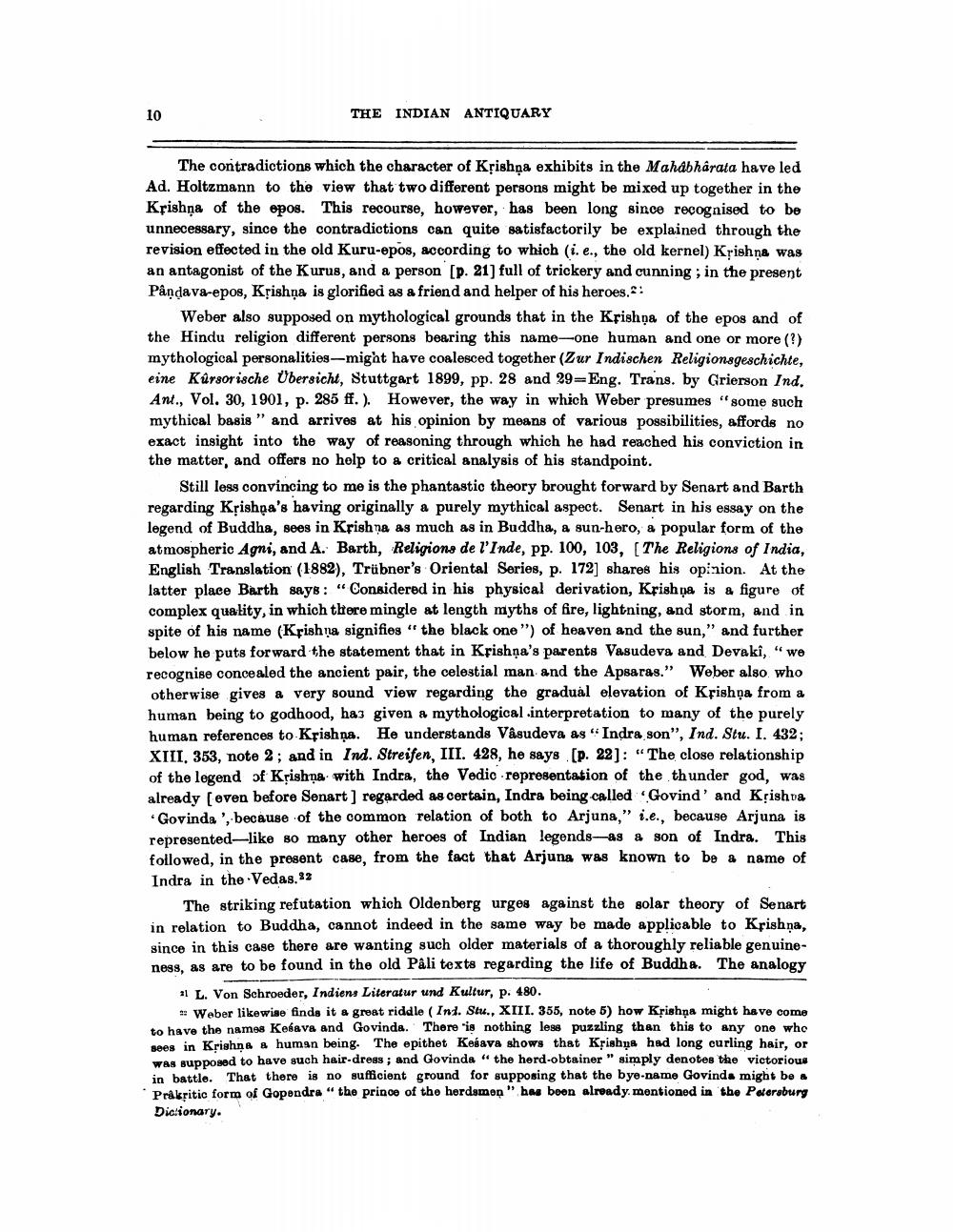________________
THE INDIAN ANTIQUARY
The contradictions which the character of Kșishṇa exhibits in the Mahabharata have led Ad. Holtzmann to the view that two different persons might be mixed up together in the Krishna of the epos. This recourse, however, has been long since recognised to be unnecessary, since the contradictions can quite satisfactorily be explained through the revision effected in the old Kuru-epos, according to which i.e., the old kernel) Krishna was an antagonist of the Kurus, and a person [p. 21] full of trickery and cunning ; in the present Påndava-epos, Krishņa is glorified as a friend and helper of his heroes.a:
Weber also supposed on mythological grounds that in the Krishộa of the epos and of the Hindu religion different persons bearing this name-one human and one or more (?) mythological personalities-might have coalesced together (Zur Indischen Religionsgeschichte, eine Karsorische Übersicht, Stuttgart 1899, pp. 28 and 29-Eng. Trans. by Grierson Ind. Ant., Vol. 30, 1901, p. 285 ff.). However, the way in which Weber presumes "some such mythical basis " and arrives at his opinion by means of various possibilities, affords no exact insight into the way of reasoning through which he had reached his conviction in the matter, and offers no help to a critical analysis of his standpoint.
Still less convincing to me is the phantastic theory brought forward by Senart and Barth regarding Kțishna's having originally a purely mythical aspect. Senart in his essay on the legend of Buddha, sees in Krishna as much as in Buddha, a sun-hero, a popular form of the atmospheric Agni, and A. Barth, Religions de l'Inde, pp. 100, 103, (The Religions of India, English Translation (1882), Trübner's Oriental Series, p. 172] shares his opinion. At the latter place Barth says: “Considered in his physical derivation, Krishna is & figure of complex quality, in which there mingle at length myths of fire, lightning, and storm, and in spite of his name (Krishna signifies " the black one") of heaven and the sun," and further below he puts forward the statement that in Krishna's parents Vasudeva and Devaki, "we recognise concealed the ancient pair, the celestial man and the Apsaras." Weber also who otherwise gives a very sound view regarding the gradual elevation of Krishya from a human being to godhood, has given a mythological.interpretation to many of the purely human references to Krishņa. He understands Vasudeva as "Indra son", Ind. Stu. I. 432; XIII. 353, note 2; and in Ind. Streifen, III. 428, he says (p. 22): "The close relationship of the legend of Krishna with Indra, the Vedic representation of the thunder god, was already seven before Sonart] regarded as certain, Indra being called Govind' and Krishna
Govinda ', because of the common relation of both to Arjuna," i.e., because Arjuna is represented-like so many other heroes of Indian legends-a9 & son of Indra. This followed, in the present case, from the fact that Arjuna was known to be a name of Indra in the Vedas.22
The striking refutation which Oldenberg urges against the solar theory of Senart in relation to Buddha, cannot indeed in the same way be made applicable to Krishna. since in this case there are wanting such older materials of a thoroughly reliable genuineness, as are to be found in the old Pali texts regarding the life of Buddha. The analogy
31 L. Von Schroeder, Indiens Literatur und Kultur, p. 480.
12 Weber likewise finds it a great riddle (Ind. Stu., XIII. 355, note 5) how Krishna might have come to have the names Kebava and Govinda. There is nothing less puzzling than this to any one who sees in Krishna a human being. The epithet Kesava shows that Krishna had long curling hair, or WAS Aupposed to have such hair.dress; and Govinda " the herd-obtainer" simply denotes the victorious in battle. That there is no sufficient ground for supposing that the bye-name Govinda might be a Prakritic form of Gopendra " the prince of the herdsmon" has boon already mentioned in the Petersburg Diccionary.




